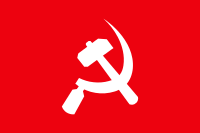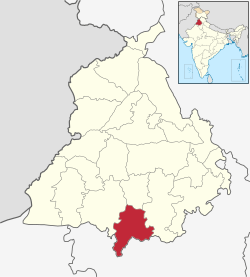Communist Party of India (Marxist–Leninist) Liberation
Communist Party of India (Marxist-Leninist) Liberation भारतीय कम्युनिस्ट पार्टी (मार्क्सवादी-लेनिनवादी) लिबरेशन | |
|---|---|
 | |
| Leader | Dipankar Bhattacharya |
| Founded | 1974 |
| Headquarters | U-90, Shakarpur, Delhi-110092 |
| Newspaper |
Liberation (English) Aajker Deshabrati (Bengali) |
| Student wing | All India Students Association |
| Youth wing | Revolutionary Youth Association |
| Women's wing | All India Progressive Women's Association |
| Labour wing |
All India Central Council of Trade Unions All India Agricultural Labour Association |
| Ideology |
Communism, Marxism-Leninism, Mao Zedong Thought[1] |
| Political position | Far-left |
| Colours | Red |
| ECI Status | State Party[2] |
| Seats in Lok Sabha |
0 / 545 |
| Seats in Rajya Sabha |
0 / 245 |
| Election symbol | |
 | |
| Website | |
| http://www.cpiml.org | |
The Communist Party of India (Marxist–Leninist) Liberation is a communist political party in India.
CPI(ML) Liberation is the largest faction of the 1970s CPI(ML) the survived all the twists and is now a prominent factor in national left politics. It has presence in several the states of the country where ir operates through various mass organisations (workers, farmers, women, youth, student unions).
History
In 1973 the original Communist Party of India (Marxist–Leninist) CPI(ML), with one group led by Sharma and another by Mahadev Mukherjee. Vinod Mishra initially belonged to Mukherjee's party, but he and the Burdwan Regional Committee broke with Mukherjee in September 1973. Mishra sought contact with the Sharma group, but the Burdwan Regional Committee was later divided and Mishra denounced the political line of Sharma (a critique, which amongst other things, called for the formation of open mass organizations, a move that almost constituted a heresy in the CPI(ML) movement at the time).[3]
In 1974 Mishra came into contact with Subrata Dutta (Jauhar), a leader of armed struggle in the plain areas of Bihar. On 28 July 1974 (the second death anniversary of Charu Majumdar) a new party Central Committee was formed with Jauhar as General Secretary and Mishra and Swadesh Bhattacharya (Raghu) as members.[3] The reorganized party became known as the 'anti-Lin Biao' group (whilst the faction of Mahadev Mukherjee constituted the 'pro-Lin Biao' group).[4] The anti-Lin Biao group became known as the CPI(ML) Liberation.[5]
Mishra served as West Bengal secretary of the new party organization. Under Mishra's leadership new dalams (guerilla squads) were formed.
In November 1975 Jauhar was killed. Mishra became the new party General Secretary in a reorganized five-member Central Committee. Mishra organized a second party congress, held clandestinely in the rural areas of Gaya district in February 1976. The congress unanimously re-elected Mishra as General Secretary.[3]
Reorientation and rectification
Mishra was the political architect of the process of re-orientation of CPI(ML) Liberation.[3] By 1976 the party had adopted a position that armed struggle would be combined with building a broad anti-Congress democratic front movement.[5] The process further elaborated through an internal rectification process initiated in late 1977. Party study circles and party schools were started from central to block level of the party structure. The theory of two line tactics started to develop.
In 1981 party tried to unify the other splintred ML factions. The party organised a unity meet with 13 ML factions to form a unified leading core . But the initiative was a failure.
The IPF
In the early 1980s CPI(ML) Liberation began building an open non-party mass movement (in direct to the original policy of CPI(ML)), the Indian People's Front (founded in April 1982). Nagbhushan Patnaik became the president of IPF. The construction of IPF, through which the underground party could develop links to other democratic forces on the basis of a popular, democratic and patriotic programme, was based on interventions by Mishra.[3] However although Mishra broke with the dogmas of the early CPI(ML), he never renounced Charu Majumdar's legacy.[4]
In the third party congress it was decided that IPF will participate in parliamentary elections. In 1989 IPF's Rameshwar Prasad won the loksabha seat from Ara (Bhojpur). In 1990, IPF won 7 seats from Bihar Legislative Assembly. Special initiatives taken foe restructuring the party and open up. IPF hold its first rally on 8 October, 1990 in Delhi.
The ASDC
In 1985, the party launched People's democratic Front (PDF) in Karbi Anglong district of Assam which won a seat in state assembly. In 1987 PDF was transformed to Autonomous State Demand Committee. A sustained mass movement by ASDC help it to sweep district council elections in 1989. In 1981, ASDC's Jayanta Rongpi became a MP in Parliament. In 1996, ASDC was able to send its five member group in Assam assembly as MLA.
In 1992, after the Fifth party congress(Held in Kolkata), the party comes out in the open from its underground status.[6] Mishra was re-elected General Secretary of the party at the sixth congress of CPI(ML) Liberation in Varanasi in October 1997.[3]
Present
The Communist Party of India (Marxist–Leninist) Liberation, led by Dipankar Bhattacharya and Kavita Krishnan, is the largest surviving faction of the CPI (M-L) and is now a prominent factor in national left politics of India. It has a presence in most of the country. Liberation has established legal overground structures (trade unions, student groups, peasant organisations etc.) and participates in elections. In the Lok Sabha elections in 1999 the party won 0.3% of the votes and one seat (the former ASDC-seat from Assam). In the 2004 elections the seat was lost, mainly due to a split within ASDC. As of 2016, the party has been able to send its representatives to the state legislative assemblies of Bihar and Jharkhand as well as the panchayats of Bihar, Jharkhand, Uttar Pradesh, West Bengal, and Punjab.
Publications
The English-language publication of the party is Liberation, and thus the party is called CPI(ML) Liberation. Apart from Liberation, the party publishes a central Hindi weekly organ, Samkaleen Lokyuddh. Some state party committees publish their own organs, like the weekly AjkBer Deshabrati in West Bengal, Nabasphulinga in Tripura, Teeppori in Tamil Nadu, Telugu Liberation in Andhra Pradesh, Kannada Liberation in Karnataka, Samkali Lok Morcha in Punjab, etc.
Mass organizations
The main mass organizations of the party are:
- Revolutionary Youth Association (RYA)
- All India Students Association (AISA)
- All India Agricultural Labour Association (AIALA)
- All India Peasants' Coordination Committee
- All India Central Council of Trade Unions (AICCTU)
- All India Progressive Women's Association (AIPWA)
- Autonomous State Demand Committee (ASDC)
States
Bihar

The party has a longstanding conflict with the feudal landlords since the beginning of CPI(ML). Siwan, Bhojpur, Arrah are the citadel of CPI(ML) movement.[7]
Bihar Legislative assembly Election 2015
CPI(ML) Liberation emerged as the third largest party in Bihar Legislative Assembly Election 2015. The party contested jointly along with CPI,CPI(M),RSP, Forward block, and SUCI(C) as a third alternative to the National Democratic Alliance and the Mahagathbandhan of Lalu Prasad Yadav and Nitish Kumar. The party won three seats from Siwan district (Satyadeo Ram from Darauli ), Katihar district (Mahboob Alam from Balrampur) and Bhojpur District (Sudama Prasad from Tarari) each. The party has a vote percentage of 1.5% in the state. All the left parties together have a vote percentage of 3.59%.
Jharkhand

Since the separation of Jharkhand from Bihar important places like Ranchi, Dhanbad, Giridih, Koderma, Jamtada and others have been field of work of the party. In Jharkhand the party is the representative of regional adivasis who have conflicts with corporates and government against improper land seizure without proper rehabilitation. The party also has conflicts with the local coal mafias.[8]
Jharkhand Panchayat Election 2015
In Giridih district the party emerged as the single largest party and won 11 zila Parishad seats during the panchayat election of 2015.[9]
Jharkhand Legislative Assembly Election 2014
The party contested in cooperation with state left parties like Marxist Coordination Centre(MCC), CPI, and CPI(M) as an alternative to the BJP and INC led alliances. The party won one seat from Giridih district (Rajkumar Yadav from Dhanwar). The party got 1.5% of vote in the state. All the left parties together got 2.5% vote in the state.
Punjab
The party here represents the landless dalit labourers through the Mazdoor Mukti Morcha which is affiliated to AIALA. The Green revolution mechanised the agriculture since the rule of Indira Gandhi. But the landless remained land less.[10]

The Malwa Uprising
In 2009 there was a land siege by the landless farmers in the Malwa region which includes Singrur, Mansa, Bhatinda under the leadership of the CPI(ML) Liberation.This was as a result of unprovided free land as was promised by the rulling parties as per Punjab Land Consolidation and Fragmentation act of 1961. The protesters struck a deal with the government to legally allot them lands as per provisions within three months. The government demanded immediate vacation of the seiged lands. the famers do not agree which led to a government crackdown on May 21.[11]
References
- ↑ http://www.cpiml.org/pgs/partyprogram/cpiml_gen_prog.htm
- ↑ "List of Political Parties and Election Symbols main Notification Dated 18.01.2013" (PDF). India: Election Commission of India. 2013. Retrieved 9 May 2013.
- 1 2 3 4 5 6 Sen, Arindam. The Life of Vinod Mishra
- 1 2 Karat, Prakash. Naxalism Today; At an Ideological Deadend. The Marxist, Volume: 3, No. 1, January–March 1985
- 1 2 Frontline. The road from Naxalbari. Volume 22 - Issue 21, 8–21 October 2005
- ↑ "Long March from Naxalbari : Most Memorable Moments". archive.cpiml.org. Retrieved 2016-11-19.
- ↑ "Communist Party of India (Marxist-Leninist) Liberation Library ItemsCommunist Party of India (Marxist-Leninist) Liberation". cpiml.org. Retrieved 2016-11-30.
- ↑ "Communist Party of India (Marxist-Leninist) Liberation Jharkhand Elections and AfterCommunist Party of India (Marxist-Leninist) Liberation". cpiml.org. Retrieved 2016-11-30.
- ↑ "Communist Party of India (Marxist-Leninist) Liberation Jharkhand Panchayat Elections : CPI(ML) Emerges as the Biggest Party in Terms of Seats in Giridih DistrictCommunist Party of India (Marxist-Leninist) Liberation". cpiml.org. Retrieved 2016-11-16.
- ↑ "Communist Party of India (Marxist-Leninist) Liberation Punjab: Popular Struggles and Left AssertionCommunist Party of India (Marxist-Leninist) Liberation". cpiml.org. Retrieved 2016-11-18.
- ↑ "Peasant uprising in Punjab". Hindustan Times. 2009-06-11. Retrieved 2016-11-18.
External links
- Party website
- Constitution of the Party, retrieved at Election Commission of India website
- "The Naxalite Movement in Central Bihar" PDF document. By Bela Bhatia. Economic and Political Weekly. 9 April 2005 pp 1536 – 1549.
- http://directaction.org.au/issue5/cpi_ml_builds_stronger_party_in_india
- http://www.hindustantimes.com/india/peasant-uprising-in-punjab/story-CmsM8Yl7BdyNAYfFB4ZNrJ.html
- http://timesofindia.indiatimes.com/city/chandigarh/MNREGS-honour-for-Mansa-village/articleshow/50842406.cms
- http://www.hindustantimes.com/punjab/ignored-by-state-govt-mansa-village-to-receive-national-honour/story-Pkiu9J1BtmVzhs1abzucUP.html
- http://timesofindia.indiatimes.com/city/patna/CPI-ML-plans-stir-for-land-reforms/articleshow/29804821.cms
- http://www.hindustantimes.com/india/in-jnu-we-are-fighting-for-india-s-democracy-cpi-ml-general-secretary/story-6rYRRqFVFjew2zlH1BBRjJ.html
- http://www.ndtv.com/india-news/senior-cpi-ml-leader-swapan-mukherjee-dies-at-63-1455165
